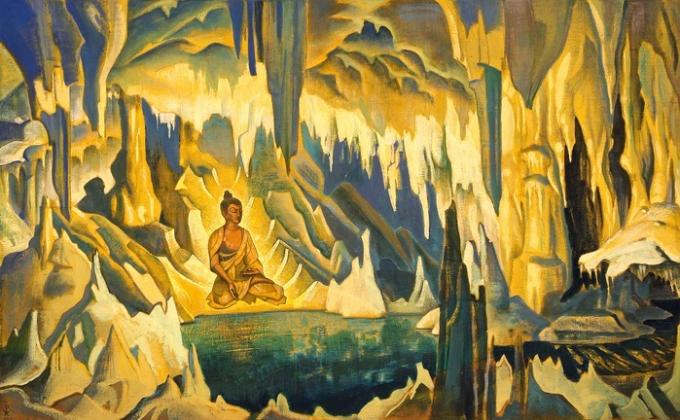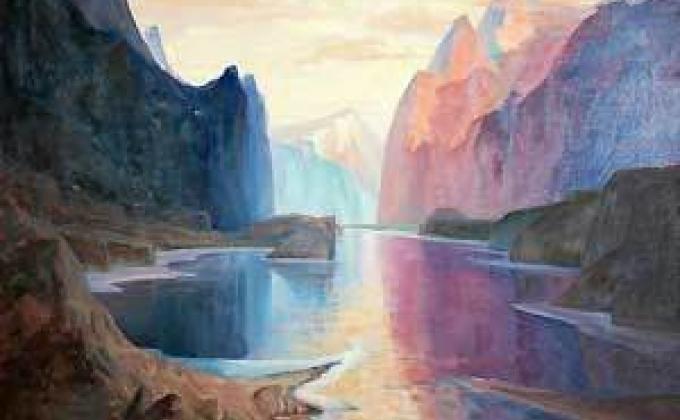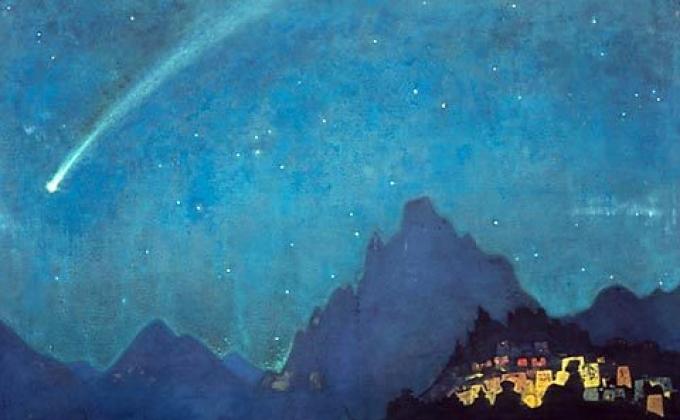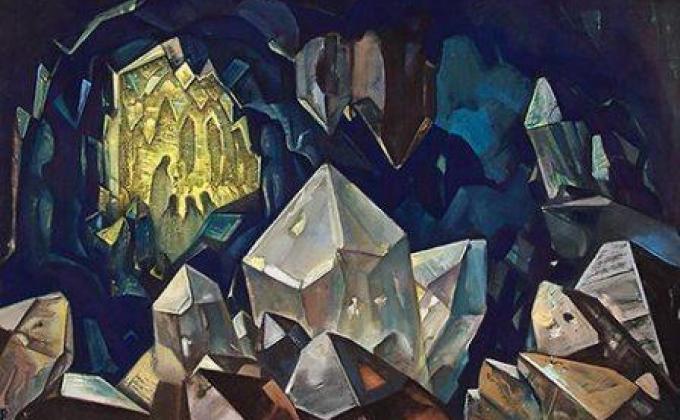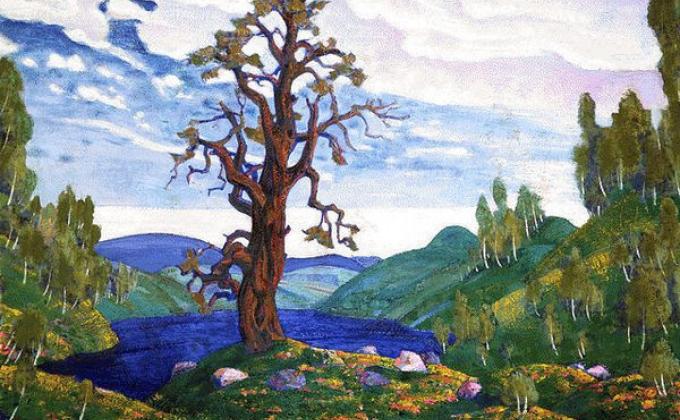
Artist, scientist, traveler, public figure, writer, thinker - Nikolai Konstantinovich Roerich was born on October 9, 1874 in St. Petersburg in the family of the famous notary Konstantin Fedorovich Roerich.
Since childhood, he was attracted by painting, archeology, history and, above all, the richest cultural heritage of the East. All this, merged together, later gave an amazing result and made the work of Nikolai Konstantinovich unique and bright.
After graduating from the Karl May Gymnasium in 1893, Nikolai Roerich simultaneously entered the Law Faculty of St. Petersburg University (graduated in 189 and the Imperial Academy of Arts. Since 1895, he has been engaged in the studio of the famous Arkhip Ivanovich Kuindzhi. At this time, he closely interacts with famous cultural figures of that time – V.V. Stasov, I.E. Repin, N.A. Rimsky-Korsakov, D.V. Grigorovich, S.P. Diaghilev.
and the Imperial Academy of Arts. Since 1895, he has been engaged in the studio of the famous Arkhip Ivanovich Kuindzhi. At this time, he closely interacts with famous cultural figures of that time – V.V. Stasov, I.E. Repin, N.A. Rimsky-Korsakov, D.V. Grigorovich, S.P. Diaghilev.
In 1897, N.K. Roerich graduated from the St. Petersburg Academy of Arts and his diploma painting "The Messenger" was acquired by the famous collector of works of Russian art P.M. Tretyakov.
Already at the age of 24, Nikolai Konstantinovich became assistant director of the Museum of the Imperial Society for the Encouragement of the Arts and at the same time assistant editor of the art magazine "World of Art".
In 1899, he met Elena Ivanovna Shaposhnikova, who became his faithful companion and spiritual companion for the rest of his life. The unity of views and deep mutual sympathy very quickly turned into strong and trembling feelings, and in October 1901 the young people got married. They will spend their entire lives hand in hand, creatively and spiritually complementing each other. Elena Ivanovna will share all the aspirations and undertakings of Nikolai Konstantinovich. In 1902, they will have a son, Yuri, a future orientalist, and in 1904 - Svyatoslav, who will choose the same path as his father.
In his books, N.K. Roerich called Elena Ivanovna an "inspirer" and a "friend". He was the first to show her each new painting and highly appreciated her artistic intuition and delicate taste. Many of the artist's canvases were created on the basis of images, thoughts and creative insights of Elena Ivanovna. But her ideas were not only in his paintings – it is difficult to name at least one area in the activities of N.K. Roerich, where they would not be. Elena Ivanovna will always be behind every creative action of Nikolai Konstantinovich, behind his poems and fairy tales, behind his paintings and trips. According to the testimony of S.N. Roerich: "Cooperation of N.[ikolaya] K[onstantinovich] and E[Lena] and [vanovna] was the rarest combination of full-sounding sound on all planes. Complementing each other, they seemed to merge in the richest harmony of intellectual and spiritual expression."
In 1903-1904, N.K. Roerich and his wife traveled through the ancient Russian cities of Russia. They visited more than 40 cities famous for their ancient monuments. The purpose of this "trip to the old days" was to study the roots of Russian culture. The result of the trip was not only a large series of paintings by the artist, but also the first articles by N.K. Roerich, in which he was one of the first to raise the question of the enormous artistic value of ancient Russian icon painting and architecture.
The artist's works on religious themes, executed in the form of murals and sketches of mosaics for Russian churches, also belong to the same period.
The multifaceted talent of Nikolai Konstantinovich Roerich was clearly manifested in his works for theatrical productions. During the famous "Russian Seasons" by S. Diaghilev, N.K. Roerich's "Polovtsian Dances" from Borodin's "Prince Igor", Rimsky-Korsakov's "The Pskovite Woman", the ballet "Sacred Spring" to Stravinsky's music took place. Thanks to Elena Ivanovna, Nikolai Konstantinovich got acquainted with the works of the outstanding thinkers of India – Ramakrishna and Vivekananda, with the literary work of R. Tagore, together they studied the Upanishads.
Acquaintance with the philosophical thought of the East was reflected in the work of N.K. Roerich. If in the artist's early paintings the defining subjects were ancient pagan Russia, colorful images of the folk epic, the primordial grandeur of the still untouched natural element ("The City is being built", "Idols", "Overseas Guests", etc.), then since the mid-1900s the theme of India and the East has been increasingly heard on his canvases and in literary works.
In 1916, due to a serious lung disease, N.K. Roerich, at the insistence of doctors, moved with his family to Finland (Serdobol), on the coast of Lake Ladoga. The proximity to Petrograd allowed from time to time to travel to the city on the Neva River and deal with the affairs of the School of the Society for the Encouragement of Arts. However, after the revolutionary events of 1917, Finland closed its borders with Russia and N.K. Roerich and his family were cut off from their homeland.
In 1919, having received an invitation from Sweden, Nikolai Konstantinovich went to exhibitions in the Scandinavian countries, and in the autumn of the same year he accepted the invitation of S.P. Diaghilev to arrange Russian operas to the music of M.P. Mussorgsky and A.P. Borodin in London and went with his family to England.
In 1920, N.K. Roerich received an offer from the director of the Chicago Institute of Art to organize a large exhibition tour of 30 cities in the USA. Nikolai Konstantinovich accepts this invitation and leaves London with his family.
N.K. Roerich was one of the few thinkers of the XX century who deeply understood the true meaning of Culture, its defining role in the development of mankind. "Culture rests on Beauty and Knowledge," he wrote. And he repeated Dostoevsky's famous phrase with a slight correction: "Awareness of Beauty will save the world." This formulation contains almost the whole meaning of cosmic evolution, which goes from chaos to order, from simple to complex, from system to Beauty. Beauty is known by man only through Culture, of which creativity is an integral part. This was also mentioned in the books of Living Ethics, the Roerichs were directly involved in the creation of which. Elena Ivanovna recorded, and Nikolai Konstantinovich perpetuated the cosmic ideas of Living Ethics in beautiful artistic images.
Embodying these ideas, N.K. Roerich launched a broad cultural and educational activity in America. In November 1921, the United Arts Master Institute opened in New York, the main goal of which was to bring peoples closer through culture and art. Almost simultaneously with him, the association of artists "Sog Ardens" ("Flaming Hearts") was established in Chicago, and in 1922 the International Cultural Center "Corona Mundi" ("Crown of the World") appeared. In November 1923, the Nicholas Roerich Museum in New York opened its doors, containing a rich collection of paintings by the artist. The institutions founded by Nikolai Konstantinovich Roerich have become major centers of culture in America, uniting many prominent artists around them.
At the same time, in 1923, the master's cherished dream comes true – on December 2, N.K. Roerich and his family arrive in India. Here begins the preparation for the most important journey in the life of the great artist – an expedition to remote areas of Central Asia. These areas have long attracted the attention of N.K. Roerich not only as an artist, but also as a scientist who was interested in a number of problems related to the world migrations of ancient peoples and the search for a common source of Slavic and Indian cultures. In addition to purely scientific goals, the expedition carried an important evolutionary task. The most difficult route of the expedition passed through Sikkim, Kashmir, Ladakh, China (Xinjiang), Russia (with a visit to Moscow), Siberia, Altai, Mongolia, Tibet, through unexplored areas of the Trans-Himalayas. The significance and results of this unique expedition have not yet been appreciated by modern geographical science. Meanwhile, having fulfilled the dream of Przhevalsky and Kozlov, the expedition of Nicholas Roerich was a triumph of Russian studies of Central Asia. By the uniqueness of the route and the collected materials, it can rightfully claim a special place among the largest expeditions of the twentieth century. The journey lasted from March 1925 to May 1928. Dozens of new mountain peaks and passes were marked on maps for the first time, archaeological sites were discovered, the rarest manuscripts were found. A huge scientific material was collected, books were written ("The Heart of Asia", "Altai – Himalayas"), about five hundred paintings were created, in which the artist immortalized a special and amazing world, a world of high beauty.
At the end of the expedition in July 1928, N.K. Roerich founded the Institute of Himalayan Studies "Urusvati", which in Sanskrit means "The Light of the Morning Star". There, in the Kulu Valley, in the Western Himalayas, Nikolai Konstantinovich and his family find their home. Here, in India, the last period of the artist's life will take place.
In 1934-1935, Nikolai Konstantinovich Roerich led an expedition to the regions of Inner Mongolia, Manchuria and China, organized by the US Department of Agriculture to study drought–resistant plants. At the time when he was on the expedition, the president of the Nicholas Roerich Museum in New York and a confidant of Nicholas Roerich, an American businessman Louis Horsch, forged documents and slandered his Teacher, illegally seized a block of shares owned by the Museum and declared himself its owner. He secretly takes out paintings, some of which he keeps for himself. Most of the paintings were put under the hammer and still adorn the private collections of American collectors. After some time, the staff devoted to the Roerichs purchased a new room for the Museum and bought a significant part of the paintings.
N.K. Roerich continues his international cultural activities. In his philosophical and artistic essays, he creates a completely new concept of Culture based on the ideas of Living Ethics. Culture, according to N.K. Roerich, is closely connected with the problems of the cosmic evolution of mankind and is the "greatest foundation" of this process.
